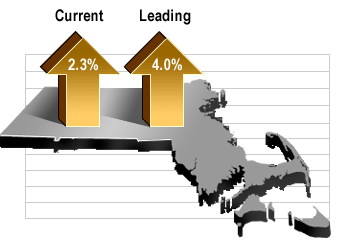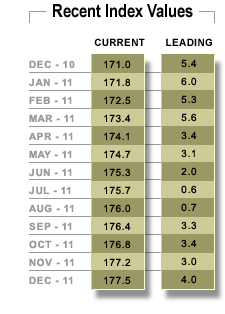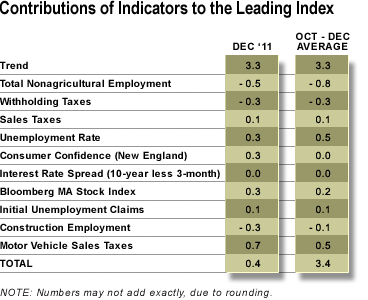Bay State Economy lags US in 4th Quarter
Slowdown may be short-lived, UMass journal reports
December 2011
 The growth in Massachusetts real gross state product growth slowed to a 2.3 percent annualized rate of growth in the fourth quarter of 2011 according to estimates released today by MassBenchmarks, the journal of the Massachusetts economy published by the UMass Donahue Institute in collaboration with the Federal Reserve Bank of Boston.
The growth in Massachusetts real gross state product growth slowed to a 2.3 percent annualized rate of growth in the fourth quarter of 2011 according to estimates released today by MassBenchmarks, the journal of the Massachusetts economy published by the UMass Donahue Institute in collaboration with the Federal Reserve Bank of Boston.
In contrast, U.S. real gross domestic product grew at a 2.8 percent annualized rate during the same period according to estimates released earlier today by the US Bureau of Economic Analysis.
This is the first time since the second quarter of 2010 that the Bay State economy has grown more slowly than the U.S. This follows state growth of 1.9 percent in the first quarter of 2011, 4.1 percent in the second quarter, and 3.2 percent in the third. The U.S. economy grew 0.4 percent, 1.3 percent and 1.8 percent in each of the first three quarters of the year.
 One indication of slowing growth in the second half of 2011 can be seen in the declining pace of job and income growth during the last two quarters of the year. While state payroll employment grew at an annual rate of 1.7 percent and 3.1 percent in the first and second quarters, job growth fell to 0.8 percent in the third quarter and 0.4 percent in the fourth quarter.
One indication of slowing growth in the second half of 2011 can be seen in the declining pace of job and income growth during the last two quarters of the year. While state payroll employment grew at an annual rate of 1.7 percent and 3.1 percent in the first and second quarters, job growth fell to 0.8 percent in the third quarter and 0.4 percent in the fourth quarter.
A similar pattern can be seen in withholding tax revenues during the second half of the year. Withholding-tax-based estimates of state wage and salary income indicate a seasonally adjusted annualized rate of growth of 3.6 percent in the first quarter and 16.1 percent in the second quarter, and declines of 2.5 and 3.0 percent in the third and fourth quarters respectively.
Three factors account for the slowdown in growth in Massachusetts relative to the nation. The first is the peaking of worldwide demand for information technology products in early 2011 and their subsequent decline during the rest of the year.
The Federal Reserve's index of U.S. industrial production in information processing equipment declined in the second quarter of 2011 but grew moderately for the year as a whole, while the BEA's estimate of U.S.-based investment in information and technology products (in nominal dollars) grew in the second and fourth quarters, but declined in the first and third quarters of 2011.
The second factor is simply the timing of growth. "To the extent that businesses accelerated their hiring during the first half of the year, they may have shifted employment and income growth from the second half of the year to the first half," noted Dr. Alan Clayton-Matthews, MassBenchmarks Senior Contributing Editor and Associate Professor of Economics and Public Policy at Northeastern University who compiles and analyzes the Current and Leading indices.
The third factor is the ongoing European debt crises, which may have already begun to negatively affect the state's export activity. Massachusetts merchandise exports in the first 11 months of 2011 were 5.7 percent higher than during the same period in 2010 as compared to the 11.5 percent state export growth experienced between 2009 and 2010.
A recession in Europe, which appears to be occurring now, could reduce Massachusetts growth through a reduction in exports. A reduction in export demand from Europe of 20 percent — which seems plausible — would reduce state economic growth by one-half to three-quarters of a percentage point.
Notwithstanding these risk factors, there is reason to believe that this slowdown may be short-lived. The MassBenchmarks Leading Index is signaling a quick return to stronger growth in the state's economy, of 3.5 percent in the first quarter and 4.0 percent in the second quarter of 2012. "The rise in the stock prices of leading Massachusetts firms, improved consumer confidence, and sharp increases in discretionary consumer spending in recent months are all encouraging signs that the recovery underway can maintain its momentum," said Dr. Martin Romitti, MassBenchmarks Managing Editor and Director of Economic and Public Policy Research at the UMass Donahue Institute.
Spending on items subject to the state regular sales tax and state motor vehicles sales tax grew at a stunning 24 percent annual rate in the fourth quarter (on a seasonally-adjusted basis), after experiencing no growth during the third quarter. Particular strength was seen in automobile purchases during this period.
There are still considerable downside risks in the near-term that may not be fully reflected in the Leading Index. These include the debt crisis in Europe, the federal budget crisis in the U.S., continued high unemployment and weakness in the housing market, and the effects of these uncertainties on consumer spending and business hiring and spending. Given the poor growth in wage and salary income in the last two quarters, the strong consumer spending and sentiment may be short-lived. The European debt crisis and the budget crisis here in the U.S. are still not resolved, and could weigh down investor confidence.
 The 10 indicators that comprise the leading index usually do not all move in tandem. Typically, some may indicate an expectation of faster than average growth, while at the same time others may indicate an expectation of slower than average growth. The following table accounts for the contributions of each towards faster or slower growth than the long-term trend of 3.3 percent. The index value is their sum.
The 10 indicators that comprise the leading index usually do not all move in tandem. Typically, some may indicate an expectation of faster than average growth, while at the same time others may indicate an expectation of slower than average growth. The following table accounts for the contributions of each towards faster or slower growth than the long-term trend of 3.3 percent. The index value is their sum.
In December, six indicators contributed to a forecast of above-trend growth: sales taxes, the unemployment rate, consumer confidence, the Bloomberg stock index for Massachusetts, initial unemployment claims, and motor vehicle sales taxes. Three indicators contributed to below-trend growth: total nonagricultural employment, withholding taxes, and construction employment. One indicator, the interest rate spread between 10‑year and 3‑month U.S. Treasury securities, contributed to average-trend growth.
In the three-month period October through December, five indicators contributed to a forecast of above-trend growth: sales taxes, the unemployment rate, the Bloomberg stock index for Massachusetts, initial unemployment claims, and motor vehicle sales taxes. Three indicators contributed to below-trend growth: total nonagricultural employment, withholding taxes, and construction employment. Two indicators contributed to average-trend growth: consumer confidence, and the interest rate spread between 10‑year and 3‑month U.S. Treasury securities.
The current and historical quarterly estimates for state domestic product growth include adjustments for changes in productivity growth. These adjustments are estimates of the quarterly deviations from trend in the growth of the ratio of output to employment and output to wage and salary income. In the fourth quarter of 2011, these adjustments subtracted 0.3 percentage points from the annual rate of growth. In the third quarter of 2011, these adjustments added 0.1 percentage points to the annual rate of growth. In the second quarter of 2011, these adjustments subtracted 0.9 percentage points from the annual rate of growth. In the first quarter of 2011, these adjustments subtracted 3.3 percentage points from the annual rate of growth. For the forecast of state domestic product growth for the first and second quarters of this year, productivity growth is assumed to return to its long-term trend. The methodology and rationale for these adjustments are available from the author upon request.
Several recent months of the indices are revised each release. These revisions are a result of the statistical method used to create the index, as well as revisions in the underlying indicators.
--------
All of the indicators except interest rates refer to Massachusetts. The current index is composed of four indicators: nonagricultural employment, withholding taxes, sales taxes, and the unemployment rate. The leading index includes these four current indicators plus the other six (leading) indicators in the contributions table. All of the indicators are as of December, except for interest rates, and the Bloomberg stock index for Massachusetts, which are through January 20. The MassInsight Consumer Confidence Index is released every third month. Intervening months are interpolated, and changes in the Conference Board's Consumer Confidence Index for the U.S. are used to extrapolate to the current month of the index, as needed. Series measured in dollars, i.e., withholding taxes, sales taxes, the Bloomberg stock index, and motor vehicle sales taxes, are deflated by the U.S. consumer price index for all urban consumers, excluding food and energy.
For a description of the methodology used to construct these indices, see: Alan Clayton-Matthews and James H. Stock, "An application of the Stock/Watson index methodology to the Massachusetts economy", Journal of Economic and Social Measurement, vol. 25 (1998/1999), pp. 183-233.
January 27, 2012
Alan Clayton-Matthews
Senior Contributing Editor, MassBenchmarks
Associate Professor of Economics & Public Policy
School of Public Policy and Urban Affairs
Northeastern University

